Alebrijes (2017-2023)
Alebrijes were originated in Oaxaca, Mexico in the 1930s by Pedro Linare, who, falling very ill, dreamt of incredible creatures, and upon recovering began to materialize his visions. The value of his alebrijes was soon recognised, others began to make them, and they soon became extremely popular with the Mexican public and international tourists, with the best exponents exhibiting in galleries.
I employed alebrije-making as an exercise with science students to explore their understandings of biology and inspire their imaginations and creative practice, alongside thinking about the role of different forms of text in authorising knowledge. As well as conjuring up an appropriate Latin/Greek scientific name, they had to produce ‘some sort of text’ in support of their alebrije. My own efforts began alongside theirs, also with imagining then making, but I subsequently switched to allowing my 'beasts' to emerge from the materials, notably driftwood.
The Horned Rainbow Glykon is a swamp-dwelling legless lizard that feeds on slow moving invertebrates, which it grabs with its teeth and gulps down in one, aided by a snake-like ‘detachable’ jaw. This enables it to consume large prey and, coupled with its ectothermic (cold-blooded) physiology, allows to go long periods without eating, as is the case with large snakes. It also hosts a pair of protuberances, one on each flank just above its tail, which are believed to be used in courtships displays and as grasping organs during mating.
The Horned Rainbow Glykon (Glykonos inda) (2023)
[driftwood, acrylic paint, beads]
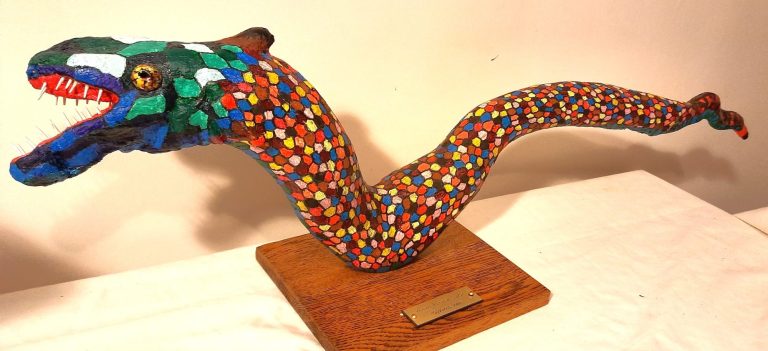
Noted for its bright colouring and habit of leaping upon its prey, the Pouncing Polychrome Panthid is an effective ambush predator. Despite its somewhat garish appearance it is actually remarkably well camouflaged because of the biodiverse grassland habitat in which it lives, and the poor colour vision
of its insect prey.
The Pouncing Polychrome Panthid
(Chromopanthidis pithima) (2022)
[driftwood, acrylic paint, beads]
The Flying Bobbit
(Eunice megaparapodia) (2020)
[80 x 20 x 8cm. Wooden knives, cedar beads and discs, coloured paper stickers, acrylic paint.]
The Flying Bobbit is a polychaete worm with extraordinarily large parapodia, which it uses to ‘fly’ through water in pursuit of its prey, in the Gulf of Tehuantepec, Mexico. It is a highly aggressive annelid, which feeds on practically anything, and has even been known to get past the defences of the Armoured Octopus. However, its colouration warns potential predators of its capacity to ingest one of its favourite prey, sea slugs. These have ingested jellyfish and been able to migrate the stinging cells (cnidoblasts) to their own epithelia without triggering them, and thereby gain protection. In consuming these sea slugs, Flying Bobbits do likewise and consequently are avoided by virtually all other marine predators, except loggerhead turtles, sunfish, spadefish and, somewhat ironically, by stinging jellyfish, which are thereby able to reclaim their cells!
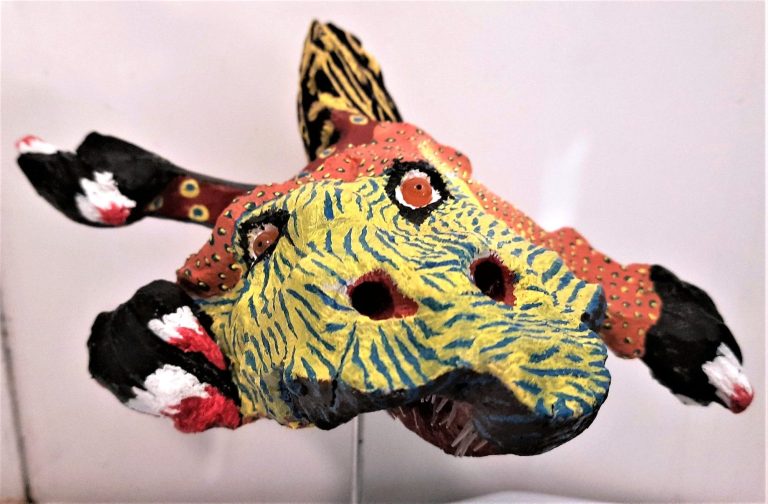
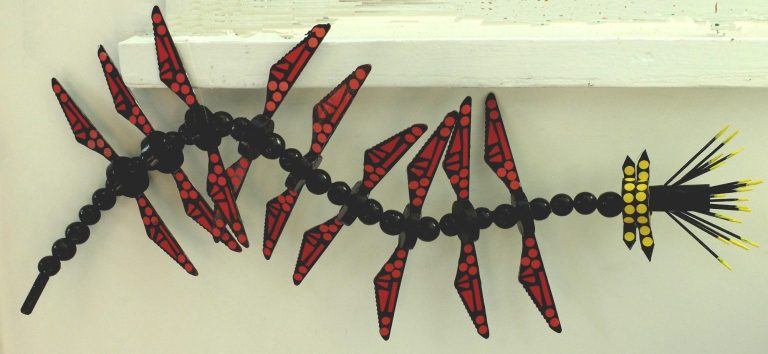
All three species were sympatric with the Jabberwock, Jubjub bird, and the frumious Bandersnatch, described by Lewis Carol in 1871. Sadly, no details of the original distributions and detailed ecology of any these species have been found, and no further records of their existence have appeared.
A Six-eyed, spotted thwark and commensal Thwark-snake (Thwarkus stiktika, Thwarkopthidis filomenos) attacked by a Beaked crabulus (Kavulas ramphostis). (2019)
Exhibited: Turner Contemporary Open Exhibition, Margate. 22nd Oct. 2021 - 20th Feb. 2022
[driftwood, acrylic paint, tiger-eye beads]
The Jungle Ooze-wallow (Bipedosavra laspi) (2018)
[17 x 10 x 40cm. Driftwood, acrylic paint, cat’s eyes]
The Jungle Ooze-wallow (Bipedosavra laspi) is thought to have been described first by the renowned explorer Sir Billy Ponsonby Farquar on the basis of remains he found one of his porters eating during his 1869 expedition to British Guyana. Much of the carcass had been consumed, so the forelimbs and unusual tail were not included in the image drawn in his expedition diary. Indeed, he described the ‘dubious’ creature as perhaps belonging to the monogeneric primitive snake family, Acrochordidae, rather than the even more unique representative of the monospecific two-legged, scale-less, aquatic, lizard family, the Bipedidae, which it was subsequently proven, to be.
The Jungle Ooze-wallow is remarkable in many ways. Accidentally rediscovered as recently as 1977, it was found living in liquid mud deposits in the Guyanan rainforest, where it apparently feeds by scooping up mud in its elongated lower jaw and sieving out small animals through its large array of teeth. With its powerful ‘suckered’ legs and elastic body it is able to squirm effortlessly through the mud and amongst tree roots. Its scales have evolved into small, shiny cell cluster patterns with a limited ability to expand and contract and thereby change the animal’s colour proportions to afford some camouflage capacity. The tail is also specially developed as a bifurcate organ with teeth-like, horny protuberances and two eye-like, bright red, raised spots, which together make it look like a head and likely confuse predators. Also, the tail ‘teeth’, which are hard and sharp, are probably used in defence. The Jungle Ooze-wallow’s eyes are also highly adapted to function in its murky habitat, being sensitive to low light levels and the slightest movements, which enables it to evade predators and helped it remain undiscovered for so long.
The Thorny Puffer-bird
(Skolopsis flatulensis) (2017)
[25 x 35 x 15cm. Tennis ball, kebab skewers, cocktail sticks, papier mâché, bottle tops, acrylic paint]
The Thorny Puffer-bird (Skolopsis flatulensis) was a flightless species recently discovered living in the undergrowth of the remote forests of Fafafa on the Island of Guff, where it fed on fruit, insects, small animals. It was a distant cousin of the Kea (Nestor notabilis), and remarkably, despite its bright colours, well camouflaged - which explains why it was only recently described. The full range of its colours only became apparent when in defensive display, such that in response to any significant threat the bird inflated itself, raising its specially adapted quill-like feathers, and opening its wings and mouth to flash bright yellow. The effect was to make the bird appear large, menacing, and surprise would-be attackers.
Moreover, at the same time its eyes would take on a hypnotising appearance and the bird produce loud bellowing calls, which sounded not unlike a large mammal passing wind. Similar calls of a higher range were used to attract mates and deter rivals during the breeding season. Unfortunately, the distinctive features of the Thorny Puffer-bird made it an object of desire for collectors, both of live and preserved specimens, the latter being preserved in their defensive posture, as is this one.
Despite attempts to protect it through the establishment of local protected areas and legal instruments, the population has been in steady decline. It was hoped that a systematic campaign conducted in collaboration with the native islanders would be effective in reversing the fortunes of this unique species. However, sadly, after attempts at captive breeding failed no living specimens have been recorded for several years and it is feared extinct.

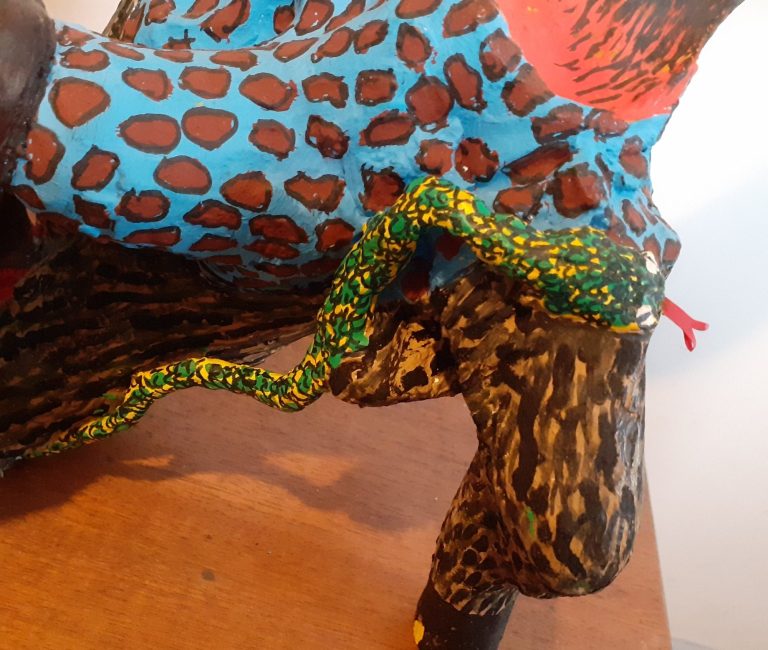
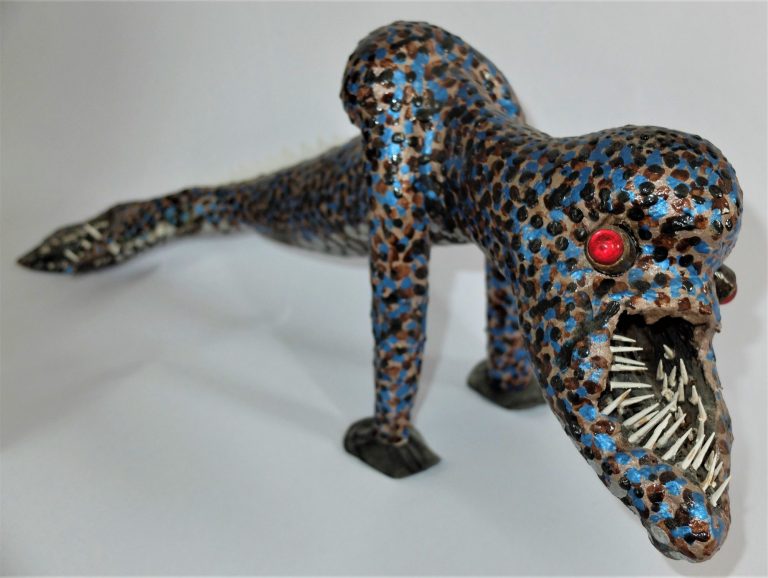
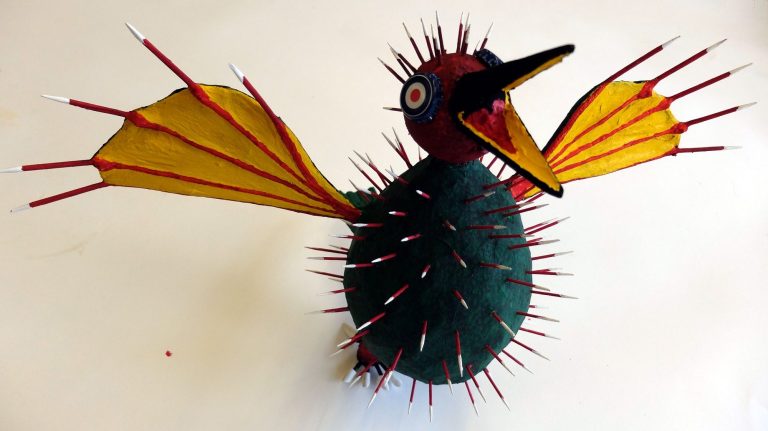
© Copyright. All rights reserved.
We need your consent to load the translations
We use a third-party service to translate the website content that may collect data about your activity. Please review the details in the privacy policy and accept the service to view the translations.